Chapter II Patent Application and Examination
1. Patent Applications
In 2005, the Office received 476,264 patent applications for three types of inventions, showing an increase of 122,457 or 34.6% year on year. Patent filings showed the following features:
(1) The annual increase of the three types of patents all hit record highs. The three types continued to increase at a high-speed rate after 20% plus increase for five consecutive years. Invention, utility model and design applications all increased very fast. There were 173,327 for invention, a 43,194 or 33.2% increase; 139,566 for utility model, a 26,741 or 23.7% increase; 163,371 for design, a 52,522 or 47.4% increase.
(2) According to the domestic and foreign filings of all three types, most of the domestic applications still were patents for utility models and industrial designs, the proportion of patents for inventions increased to 24.4%, while most of the foreign ones were patents for inventions, accounting for 85.8%.
(3) Domestic applications still had an upper hand over the foreign ones. In term of the technology-enriched patent, invention, domestic applications increased 42.1%, 18% higher than that of 24.1% hike of foreign applications. There were 93,485 domestic applications, 17.1% higher than 79,842 foreign applications.
Table 1 Applications for Three Kinds of Patents According to Service and Non-Service in 2005
| Kinds of Patents | Total | Domestic | Foreign | ||||||||
| Total (B) | Service (A) | Non-Service (A) | Total (B) | Service (A) | Non-Service (A) | Total (B) | Service (A) | Non-Service (A) | |||
| Accumulated Total | Number of Applications %(A/B) | 2761189 | 1310264 | 1450925 | 2257515 | 829146 | 1428369 | 503674 | 481118 | 22556 | |
| 100.0% | 47.5% | 52.5% | 100.0% | 36.7% | 63.3% | 100.0% | 95.5% | 4.5% | |||
| This Year | Total | Number of Applications %(A/B) | 476264 | 248858 | 227406 | 383157 | 158882 | 224275 | 93107 | 89976 | 3131 |
| 100.0% | 52.3% | 47.7% | 100.0% | 41.5% | 58.5% | 100.0% | 96.6% | 3.4% | |||
| Invention | Number of Applications %(A/B) | 173327 | 139845 | 33482 | 93485 | 62270 | 31215 | 79842 | 77575 | 2267 | |
| 100.0% | 80.7% | 19.3% | 100.0% | 66.6% | 33.4% | 100.0% | 97.2% | 2.8% | |||
| Utility Model | Number of Applications %(A/B) | 139566 | 48050 | 91516 | 138085 | 46879 | 91206 | 1481 | 1171 | 310 | |
| 100.0% | 34.4% | 65.6% | 100.0% | 33.9% | 66.1% | 100.0% | 79.1% | 20.9% | |||
| Design | Number of Applications %(A/B) | 163371 | 60963 | 102408 | 151587 | 49733 | 101854 | 11784 | 11230 | 554 | |
| 100.0% | 37.3% | 62.7% | 100.0% | 32.8% | 67.2% | 100.0% | 95.3% | 4.7% | |||
Table 2 Distribution of Domestic Non-Service and Service Applications, 2005
|
Total |
Non-Services |
Service |
||||
|
A |
B |
B |
B |
B |
||
|
Total |
Universities and Colleges |
Scientific Research Institute |
Enterprises |
Organizations |
||
|
383157 |
224275 |
158882 |
19921 |
9746 |
127397 |
1818 |
|
|
|
(B/A) |
12.54% |
6.13% |
80.18% |
1.14% |

Table 3 Distribution of Domestic Service Applications, 2002-2005
|
|
2002 |
2003 |
2004 |
2005 |
|
Total |
81242 |
102456 |
111280 |
158882 |
|
Universities and Colleges |
5981 |
10252 |
12997 |
19921 |
|
Scientific Reaearch Institutes |
5373 |
6998 |
6709 |
9746 |
|
Enterprises |
68962 |
84117 |
90148 |
127397 |
|
Organizations |
926 |
1089 |
1426 |
1818 |

Table 4 Top Ten Foreign Corporations According to Their Applications in 2005
| No. | INID | Name of Corporations | Number |
| 1 | KR | Samung Electronics | 3508 |
| 2 | JP | Matsushita | 3042 |
| 3 | NL | Philips | 2709 |
| 4 | JP | Song | 1652 |
| 5 | KR | LG | 1424 |
| 6 | US | IBM | 1213 |
| 7 | JP | Toshiba | 1177 |
| 8 | JP | SEIKO | 1119 |
| 9 | KR | Samung SDI | 1052 |
| 10 | JP | Canon | 940 |
Table 5 Top Ten Domestic Universities and Colleges According to Their Applications in 2005
| No. | Name of Universities and Colleges | Number |
| 1 | Zhejiang University | 1244 |
| 2 | Shanghai Jiaotong University | 1093 |
| 3 | Qinghua University | 930 |
| 4 | Jiangnan University | 683 |
| 5 | Southeast University | 457 |
| Tianjin University | 457 | |
| 7 | Harbin Industrial University | 404 |
| 8 | South China University For Science & Technology | 399 |
| 9 | Fudan University | 378 |
| 10 | Wuhan University | 279 |
Table 6 Top Ten Domestic Scientific Research Institutes According to Their Applications in 2005
| No. | Name of Scientific Research Institutes | Number |
| 1 | Shanghai Light Mechanics Institute,Chinese Academy of Sciences | 514 |
| 2 | Semiconductor Institute,Chinese Academy of siences | 388 |
| 3 | Guiyang AL & Mg Design Institute | 380 |
| 4 | Dalian Chemistry and Physicis Institute,Chinese Academy of Sciences | 362 |
| 5 | Industry Technology Research Institute | 355 |
| 6 | Changchun Light Mechanics and Physics ,Chinese Academy of Sciences | 338 |
| 7 | Metal Institute,Chinese Academy of Sciences | 336 |
| 8 | Changchun Applied Chemistry Institute,Chinese Academy of Sciences | 280 |
| 9 | Institute of Chemistry,Chinese Academy of Sciences | 258 |
| 10 | Computing Technology Institute,Chinese Academy of Sciences | 234 |
Table 7 Top Ten Domestic Enterprises According to Their Applications in 2005
| No. | Name of Enterprises | Number |
| 1 | Huawei Technology | 3409 |
| 2 | Hon Hai Precision Industry | 2093 |
| 3 | Shanghai Si Di Consultation Firm | 2039 |
| 4 | LG Electronics (Tianjin) | 1850 |
| 5 | Hong Fu Jin Precision Industry (Shenzhen) | 1749 |
| 6 | LG Electronics (China) R & D Center | 983 |
| 7 | ZTE Telecommunications | 972 |
| 8 | Chongqing Li Fan (Group) | 820 |
| 9 | BYD | 753 |
| 10 | Chang An Auto (Group) | 747 |
Table 8 Top Ten Foreign Corporations According to Their Applications of Invention in 2005
| No. | INID | Name of Corporations | Number |
| 1 | KR | Samung Electronics | 3159 |
| 2 | NL | Philips | 2602 |
| 3 | JP | Matsushita | 2530 |
| 4 | JP | Song | 1456 |
| 5 | US | IBM | 1213 |
| 6 | KR | LG Electronics | 1126 |
| 7 | JP | Toshiba | 1075 |
| 8 | KR | Samung SDI | 1052 |
| 9 | JP | SEIKO | 1045 |
| 10 | JP | Canon | 915 |
Table 9 Top Ten Domestic Universities and Colleges According to Their Applications of Invention in 2005
| No. | Name of Universities and Colleges | Number |
| 1 | Shanghai Jiaotong University | 1049 |
| 2 | Zhejiang University | 976 |
| 3 | Qinghua University | 826 |
| 4 | Tianjin University | 414 |
| 5 | Harbin Industrial University | 384 |
| 6 | Fudan University | 357 |
| 7 | South China University For Science & Technology | 292 |
| 8 | Southeast University | 263 |
| 9 | Xi'an jiaotong University | 245 |
| 10 | Nanjing University | 233 |
Table 10 Top Ten Domestic Scientific Research Institutes According to Their Applications of Invention in 2005
| No. | Name of Scientific Research Institute | Number |
| 1 | Institute of Semiconductor, Chinese Academy of Sciences | 374 |
| 2 | Shanghai Light Mechanics Institute, Chinese Academy of Sciences | 360 |
| 3 | Industry Technology Research Institute | 348 |
| 4 | Dalian Chemistry and Physics Institute,Chinese Academy of Sciences | 344 |
| 5 | Metal Institute,Chinese Academy of Science | 274 |
| 6 | Changchun Applied Chemistry Institute,Chinese Academy of Sciences | 270 |
| 7 | Institute of Chemistry,Chinese Academy of Sciences | 256 |
| 8 | Changchun Light Mechanics Institute,Chinese Academy of Sciences | 248 |
| 9 | Computing Technology Institute,Chinese Academy of Sciences | 230 |
| 10 | Pretrochemical Science Institute ,SINOPEC | 212 |
Table 11 Top Ten Domestic Enterprises According to Their Applications of Invention in 2005
| No. |
Name of Enterprises |
Number |
| 1 | Huawei Technology | 3164 |
| 2 | LG Electronics (Tianjin) | 1669 |
| 3 | Hon Hai Precision Industry | 1255 |
| Hong Fu Jin Precision Industry (Shenzhen) | 1255 | |
| 5 | LG Electronics (China) R & D Center | 919 |
| 6 | ZTE Telecommunications | 817 |
| 7 | SINOPEC | 535 |
| 8 | AUO | 468 |
| 9 | Shanghai LG | 437 |
| 10 | Benq | 406 |
By December 31,2005 an accumulated number of 2,761,189 patent applications were filed with the Office. Among them, 2,257,515 were domestic filings, accounting for 81.8% of the total, and 503, 674 were foreign applications, accounting for 18.2%.
Since China officially became a member state of the Patent Cooperation Treaty (PCT) in 1994, by December 31,2005, the Office received a total of 9,567 international applications. 9,590 international search copies, and established 8,489 international search reports. The Office also received 3,954 demands for international preliminary examination, and 3,621 international preliminary examination reports. Of the 198,830 international applications entering China's national phase, 198,729 filings were for invention patents and 101 for utility models.
In 2005, the Office received 2,438 international applications, 2,375 international search copies, and established 2,279 international search reports. The Office also received 446 requests for international preliminary examination, and established 662 reports. Of the 40,804 international applications entering China's national phase, 40,761 filings were for invention patents and 43 for utility models.
2. Distribution of Patent Applications by Region, Industry, and Country
As compared with the previous year, the ranking did not change much with regard to the origins of domestic patent applications in 2005. The top ten provinces were Guangdong, Zhejiang, Jiangsu, Shanghai, Shandong, Beijing, Taiwan, Liaoning, Tianjin, Hubei.
In 2005, domestic service applications increased significantly faster than previous years. Domestic invention service applications made the largest contribution. The number of service patent applications filed by domestic enterprises reached 158,882, a rise of 47,602 or 42.8% against the previous year, 62,270 for invention, an increase of 20,520 or 49.1%. The number of patent applications filed by domestic companies was 127,397, an increase of 37,249 or 41.3%. The number of patent applications filed by domestic colleges and universities was 19,921, an increase of 6,924 or 53.3%. By December 31,2005, 132 countries and regions had filed their applications in China. In the year 2005, China received applications from 93 countries and regions, for 5 of which it was the first time to file applications in China. The newcomers were Aruba, Kyrgyzstan, Lithuania, Puerto Rico and Serbia and Montenegro. The top ten countries in terms of the number of patent applications were Japan, USA, the Republic of Korea, Germany, the Netherlands, France, Switzerland, Italy, United Kingdom and Sweden.
Table 12 Top Ten Provinces and Municipalities According to Their Applications Filed in 2005
| No. |
Provinces or cities |
Number |
| 1 | Guangdong | 72220 |
| 2 | Zhejiang | 43221 |
| 3 | Jiangsu | 34811 |
| 4 | Shanghai | 32741 |
| 5 | Shandong | 28835 |
| 6 | Beijing | 22572 |
| 7 | Taiwan | 20599 |
| 8 | Liaoning | 15672 |
| 9 | Tianjin | 11657 |
| 10 | Hubei | 11534 |
Table 13 Top Ten Countries According to Their Applications Filed in 2005
| No. |
States |
Number |
| 1 | Japan | 36221 |
| 2 | the USA | 20395 |
| 3 | Korea | 9300 |
| 4 | Germany | 7502 |
| 5 | the Netherlands | 3988 |
| 6 | France | 3190 |
| 7 | Switzerland | 2106 |
| 8 | Italy | 1632 |
| 9 | the UK | 1613 |
| 10 | Sweden | 1101 |
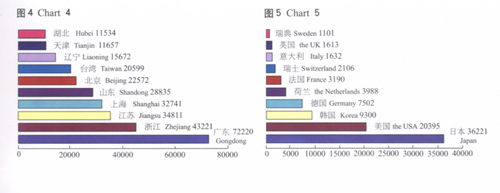
3. Distribution of Patent Applications by Technical Field
287,126 applications for inventions and utility models were classified according to IPC, a rise of 47,136 or 19.6% over the previous year.
As far as the IPC classification of invention patent applications in 2005 was concerned, patent filing showed the following features:
(1) Applications relating to preparations for medical, dental, or toilet purposes (A61K) led for the 14th consecutive year, among them up to 80% were domestic applications. Applications relating to electric digital processing (G06F) ranked 2nd, domestic applications accounted for nearly 50.0%. Applications related to transmission of digital information(H04L)ranked the 3rd, more than 50% of which were from domestic applicants. Applications related to medicine (A61K) and electronic data processing (G06F) ranked among the top three for tenth consecutive year.
(2) The top ten subclasses that were led by foreign applications were information storage (G11B), semiconductor component (H01L), optical device and optical system (G02B). Each accounted for over 65% of the total in their respective subclass.
Table 14 Applications for Patents for Inventions and Utility Models Classified According to IPC in 2005
| A-H Total | A | B | C | D | E | F | G | H | |
| Accumulated Total | 1930984 | 434928 | 369214 | 187259 | 41561 | 123951 | 246783 | 257619 | 269669 |
| 100.0% | 22.5% | 19.1% | 9.7% | 2.2% | 6.4% | 12.8% | 13.3% | 14.0% | |
| Total in 2005 | 287162 | 57692 | 47676 | 29451 | 5352 | 16015 | 32691 | 45951 | 52334 |
| 100.0% | 20.1% | 16.6% | 10.3% | 1.9% | 5.6% | 11.4% | 16.0% | 18.2% | |
| Invention | 160869 | 26650 | 18970 | 26142 | 3045 | 4327 | 11611 | 31951 | 38173 |
| 100.0% | 16.6% | 11.8% | 16.3% | 1.9% | 2.7% | 7.2% | 19.9% | 23.7% | |
| Utility Model | 126293 | 31042 | 28706 | 3309 | 2307 | 11688 | 21080 | 14000 | 14161 |
| 100.0% | 24.6% | 22.7% | 2.6% | 1.8% | 9.3% | 16.7% | 11.1% | 11.2% |
Table 15 Top Ten IPC Sub-Classes of Applications for Patent for Inventions in 2005
| Total | Sub-class | Number | Residents | Sub-class | Number | Non-Residents | Sub-class | Number |
| 1 | A61K | 12514 | 1 | A61K | 10047 | 1 | G06F | 4335 |
| 2 | G06F | 8455 | 2 | G06F | 4120 | 2 | H01L | 3728 |
| 3 | H04L | 6305 | 3 | H04L | 3364 | 3 | H04L | 2941 |
| 4 | H01L | 5428 | 4 | H04Q | 2007 | 4 | H04N | 2796 |
| 5 | H04N | 4498 | 5 | H04N | 1702 | 5 | A61K | 2467 |
| 6 | H04Q | 3145 | 6 | H01L | 1700 | 6 | G11B | 2141 |
| 7 | G11B | 2698 | 7 | G01N | 1526 | 7 | C07D | 1491 |
| 8 | C07D | 2497 | 8 | A23L | 1426 | 8 | G02F | 1441 |
| 9 | G01N | 2445 | 9 | H04M | 1394 | 9 | G02B | 1267 |
| 10 | G02F | 2286 | 10 | C07C | 1201 | 10 | H04B | 1248 |
Table 16 Top Ten IPC Sub-Classes of Applications for Patent for Utility Models in 2005
| Total | Sub-class | Number | Residents | Sub-class | Number |
| 1 | B65D | 3265 | 1 | B65D | 3233 |
| 2 | H01R | 2324 | 2 | H01R | 2223 |
| 3 | A47G | 2081 | 3 | A47G | 2067 |
| 4 | G06F | 1975 | 4 | G06F | 1951 |
| 5 | F16K | 1953 | 5 | F16K | 1944 |
| 6 | A47J | 1945 | 6 | A47J | 1923 |
| 7 | A61B | 1750 | 7 | A61B | 1734 |
| 8 | A61M | 1694 | 8 | A61M | 1684 |
| 9 | E21B | 1470 | 9 | E21B | 1470 |
| 10 | E06B | 1386 | 10 | E06B | 1359 |
Since 98.7% applications for utility models in 2005 were domestic applications, the above ranking reflected the overall status of domestic utility model applications. For utility model filings, those related to containers or packaging for storage or transportation of materials (B65D) ranked first for the 12th consecutive year. Applications relating to electric transmission linkage (H01R) ranked 2nd, and applications related to home wares and kitchenware (A47G) ranked 3rd.
Table 17 Three Kinds of Domestic and Foreign Patents Granted According to Service and Non-Service in 2005
|
Kinds of Patents |
Total | Domestic | Foreign | ||||||||
| Total (B) | Service (A) | Non-Service (A) | Total (B) | Service (A) | Non-Service (A) | Total (B) | Service (A) | Non-Service (A) | |||
| Accumulated Total | Granted% %(A/B) | 1469502 | 680746 | 788756 | 1264887 | 485258 | 779629 | 204615 | 195488 | 9127 | |
| 100.0% | 46.3% | 53.7% | 100.0% | 38.4% | 61.6% | 100.0% | 95.5% | 4.5% | |||
| This Year | Total | Granted% %(A/B) | 214003 | 112338 | 101665 | 171619 | 71518 | 100101 | 42384 | 40820 | 1564 |
| 100.0% | 52.5% | 47.5% | 100.0% | 41.7% | 58.3% | 100.0% | 96.3% | 3.7% | |||
| Invention | Granted% %(A/B) | 53305 | 46316 | 6989 | 20705 | 14761 | 5944 | 32600 | 31555 | 1045 | |
| 100.0% | 86.9% | 13.1% | 100.0% | 71.3% | 28.7% | 100.0% | 96.8% | 3.2% | |||
| Utility Model | Granted% %(A/B) | 79349 | 30202 | 49147 | 78137 | 29191 | 48946 | 1212 | 1011 | 201 | |
| 100.0% | 38.1% | 61.9% | 100.0% | 37.4% | 62.6% | 100.0% | 83.4% | 16.6% | |||
| Design | Granted% %(A/B) | 81349 | 35820 | 45529 | 72777 | 27566 | 45211 | 8572 | 8254 | 318 | |
| 100.0% | 44.0% | 56.0% | 100.0% | 37.9% | 62.1% | 100.0% | 96.3% | 3.7% | |||
4. Patent Granting
By December 31, 2005, SIPO had granted an accumulated total of 1,469,502 patents. In 2005, 214,003 patents were granted, with an increase of 12.5% over 23,765 of the previous year.
In 2005, 53,305 applications for patents for invention were published, an increase of 3,943 or 12.5%.
As far as utility models were concerned, 79,349 were granted in 2005, with an increase of 8,726 or 12.4%.
In 2005, 81,349 patents for industrial designs were granted, with an increase of 15.8% against 11,094 of the previous year.
5. Analysis and Forecast on Patent Applications Relating to Hybrid Electric Vehicle (HEV)
HEV is one of the popular topics in industry in 2005. HEV has advantages of traditional internal-combustion engine vehicle and pure electric vehicle, at the same time many automobile manufacturers, institutes around the world have paid great attention to HEV due to its advantages in fuel economy and the like. We have analyzed the situation of HEV patent applications in 2003 and 2004 and follow the situation of HEV patent applications in this year.
Chart 1 shows trend of HEV patent applications' amount from 2003 to 2005. It is obvious from chart 1 that the patent applications amount in 2005, which is compared with that in 2003 and 2004, are reduced. In 2003, the number of patent applications published domestically relating to HEV is more than 100 pieces, in which the applications relating to "core technology", such as HEV driving unit and configuration possess great proportion in the realm. In 2004, the number of patent applications published domestically relating to HEV is about 96 pieces, in which the applications relating to control method of HEV possess great proportion. In 2005, the number of patent applications published domestically relating to HEV is about 65 pieces, in which the applications relating to "core technology" are lessened. Many applications relate to "periphery technology", such as test and research system for fuel cell hybrid drive system, standardization method for HEV controller and the like. However, the applications relating to HEV control device and control method still take great proportion. The gradual reduction of the applications in recent three years indicates that HEV technology has maturated by degrees, now it has stepped into a stage that focuses on industrialization and general adoption of the market principle.
As far as the applicants nation distribution in chart
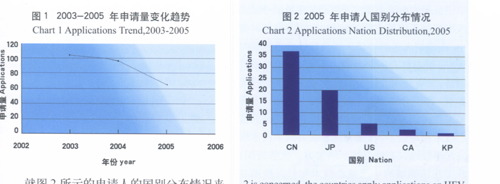
2 is concerned, the countries apply applications on HEV are relatively concentrate. In recent years, Japan and America have a large number of applications in China. Especially, Toyota, Honda and Nissan, the three Japanese automobiles companies all along have great application amount. However, applications applied by Chinese applicants in 2005 occupy a great proportion in the realm, about 55%. More than twenty enterprises and institutes, including Qinghua University, Shanghai Jiaotong University, FAW Group, SAIC (Shanghai Automotive Industry Corporation) , Institute of Automobile Engineering, have applied many applications concerned
We can see from chart 3 which shows domestic applicants distribution, that in 2005 service inventions approximately reach 75%. This value has greatly increased compared with last two years. It also changes the situation of excessive individual applications and lower technical levels.

Table 1 lists amount and titles of the applications on HEV of Japanese Toyota and Chinese Qinghua University in 2005. Applications of Toyota mainly relate to drive unit and control system of HEV and the like technology. The contents of these applications are relatively concentrate. Applications of Qinghua University involve a wider scope. The pivotal hybrid power system, power unit assembly controller, and peripheral standardization method for controller, test and research system are all included. Some developed countries including Japan and America start research in HEV realm earlier; the core technique that they control is more. Our country starts research in HEV technology later. Our advantage in the aspects of core technique is weaker. The applications relating to core technology and peripheral technology are applied together by domestic applicants. At the same time they emphasize the related peripheral technology.
Anticipating accordingly, in future several years, applications concerning core technology of HEV won't significantly increase, but applications concerning peripheral technology of HEV will keep ascending.
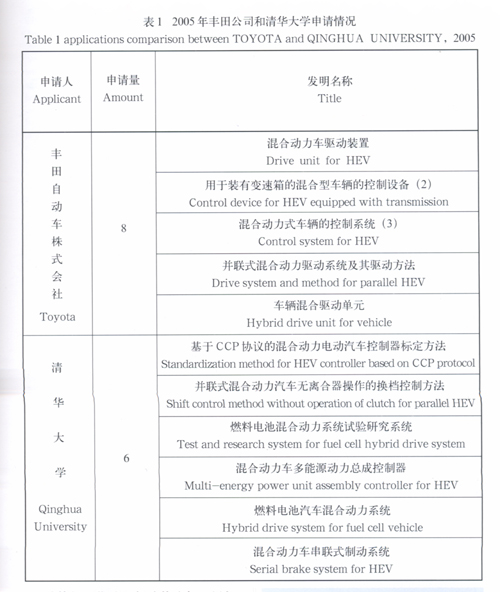
6. Analysis and Forecast on Patent Applications Relating to the Computer Image Processing Technology
The computer image processing, a kind of technology for transforming image signal into digital signal and dealing with the sign by means of the computer, is also named as the digital image processing, and generally relates to the technology about the optics, the electronics, the mathematics and the computer, etc. The computer image processing technology includes the image acquisition, the image digitization, the image enhancement or restoration, the image coding and compression, the image segmentation and description, the image matching and recognition, three dimensional image reconstruction, the image display and copying, the image real time processing and the Image analysis etc.. With the rapid development of the communication technology whose core is the computer technology, the computer image processing technology has been widely applied to kinds of fields and plays an important role more and more.
The patent applications on the computer image processing mainly relate to the following international patent classification:G06T (image data processing or generation, in general), G06K9 (methods or arrangements for reading or recognizing printed or written characters or figure), G06K11 (methods or arrangements for graph-reading), H03M (coding, decoding or code conversion). Now according to the situation of applications based on said international patent classification, the development situation of the patent applications on computer image processing is analyzed.
In recent years, the amount of the patent applications on the computer image processing keeps increasing. By the end of 2005, the total number of the applications published has reached 7,485. The distributing situation of these applications' countries is shown in figure 1. It can be seen from the statistical results, the amount of the domestic patent applications is 3,460, accounting for 46% of the total. These patent applications were mainly filed by the following corporations, such as Lijie Computer (Taiwan), Hongguang Fineind (Taiwan), Univ. Shanghai Jiaotong, Univ. Qinghua、Automation Institute Of Chinese Academy Of Sciences and Beijing Vimicro Corp etc.. The foreign patent application amount is 4,385, accounting for 54% of the total. The total filed from Japan is 1,847, accounting for 25% of the total. The total filed from America is 903, accounting for 12% of the total. The total filed from Korea is 378, accounting for 5% of the total. The total filed from Holland is 274, accounting for 3.7% of the total. These foreign patent applications were mainly filed by some major companies of America, Japan, Korea, Holland, such as SONY Corp, Samsung Electronics CO LTD, Canon KK, Matsushita Electric Ind. CO LTD, Konink Philips Electronics NV, etc.
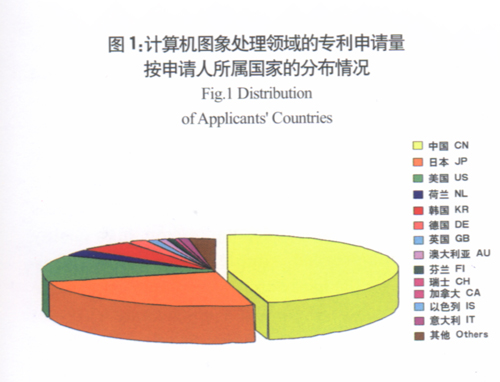
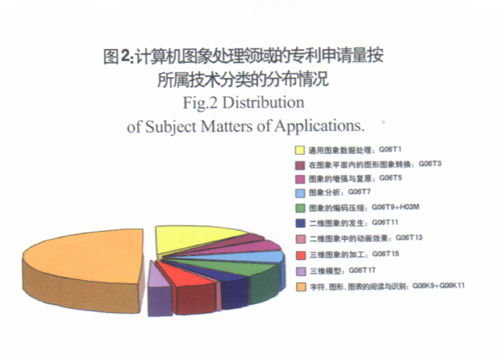
The distributing situation of the subject matters of the applications on the computer image processing is shown in figure 2. It can be seen from the figure, the subject matters of these applications mainly focus on the following technology content, such as image reading or recognizing(accounting for 50% of the total), general purpose image data processing ( accounting for 13% of the total), image coding and compression ( accounting for 8% of the total), image analysis(accounting for 7% of the total).
According to the further statistics, the subject matters of the applications on image reading or recognizing in recent year mainly focus on the following aspects, such as the technology about optical character recognition, fingerprints or face recognizing, bar code and digital watermark.
In recent years, the total number of the applications on the image coding and compression increases rapidly. As a whole, the applications on the entropy coding are more than those on the redundancy coding. In particular, these applications mainly relate to the predictive coding, the motion compensation and prediction coding, the sub-band coding, the filter coding, the block coding with statistic etc. In addition, more than 7% of the applications on the image coding and compression relate to JPEG or MPEG standard. Recently, the total number of the applications on the self-adapting NN coding and the wavelet transformation increases rapidly.
The patent applications on the general-purpose image data processing mainly refer to the methods or the devices for processing or generating the general-purpose image data . The patent applications on the image analysis mainly focus on geometric attributes obtaining, the analysis of motion and texture.
In the future, the computer image processing technology, as an important aspect of the problem on "information superhighway", will be paid more and more attention by the researchers from different countries. The development situation of this technology correlates greatly with some central electron technology and electronic products today or in the future. In order to improve the practicality of the image communication, it can be affirm that, the researchers will keep on committing themselves to research the image coding and compression technology provided with high compress ratio, fast compress and decompression, high quality image decompressed, simple arithmetic and easy realization by the hardware. Accordingly , the image coding and compression will keep on being a hotspot field, which the patent applications focus on. In addition, the computer image processing technology, as a special research field, is becoming a universal tool applied in research of all kinds of the fields and the man-machine interface. As a result, the method for improving the effect of image recognition by means of the theory about the artificial intelligence, the machine vision and the nerve net will be another focus of the application and research.
7. Analysis and Forecast on Patent Applications Relating to Information Record Technology
Technology in the field of information record has been rapidly developed for the last decade following the appearance of DVD. DVD is the next generation image and information record carrier following with VTR and CD. The DVD player has high definition image and hi-fi quality sound, and it is high-technology product gathering laser technique, precision electromechanical control technique and numeral compress technique together. In recent years, the development direction of data storage technology is higher storage density, faster access speed as well as more fine reproducing quality. Therefore the patent applications relating to DVD are increased day by day.
According to incomplete statistics, from January 1, 2005 to December 20, 2005, the amount of invention patent applications belonging to International Patent Classification(IPC)G11B (Information Storage Based on Relative Movement between Record Carrier and Transducer) in China reaches to 448. Among them, the amount of foreign patent applications is 402, accounting for 89.7%of the total, most applications are from Japan, Korea, USA, France etc(in the order of application amount). The amount of applications from Japan is 278, accounting for 62.5%, and it shows that Japan still remains its consistent dominant position in the field of G11B. Besides the amount of domestic patent applications is 46, accounting for 10.3%, and they are mainly filed by Weishi Elec. CO. LTD, Qinghua University, Shanghai Jiaotong University, Shanghai Institute of Optics & Precision Mechanism, as well as other research institutions.
The primary technical contents of these patent applications relate to four aspects. First, patent applications relate to recording and reproducing by optical means, e.g. recording using a thermal beam of optical radiation and reproducing using an optical beam at lower power, thereof recording carrier and head(IPC: G11B7/00, G11B7/24, G11B7/12), and the amount of these applications is 187. Second, patent applications relate to recording and reproducing by magnetization(IPC: G11B5/60, G11B5/66), and the amount of these applications is 80, including the recording carrier consisted of several layers and processes for apparatus specially adapted for manufacturing recording carrier. Third, patent applications relate to signal processing of recording or reproducing method(IPC: G11B20/10、G11B20/12、G11B20/18), and the amount of these applications is 136, including digital recording or reproducing, formatting and error detection or correction. Forth, the amount of patent applications relating to constructional parts(IPC: G11B33/00)is 19.
The development of optical digital store technology, on the one hand is the improvement on the basis of classical DVD technology, on the other hand is using different optical theory to do compact technique store. Main means are to use the shorter wavelength laser and the optical head of larger numerical value aperture; the further improvement of the construction and material of the record disk, optical system, the electromechanical control etc; and the further development in the application technology of the signal modulation demodulation, data encoding and decoding, the integrated circuit and the manufacturing of optical disk. In the future, the patent applications relating to optical and digital encoding and decoding will become more active.
8.Analyses and Forecast on Patent Applications
In the field of Anti Avian Influenza
In the past 2005, Avian influenza (AI) spread all over the world. While triggering a worries and panic on global human influenza, the threat of AI has promoted the global cooperation of science and technology.
Epidemic influenza (flu) is a kind of respiratory infectious disease induced by influenza virus, and its most distinctive biological characteristic is its antigenic variation. Influenza virus can be divided into types A, Band C. Type A is further divided into several sub-types (HxNy) based on the antigenic difference of hemagglutinin and neuraminidase. The avian influenza sweeping the world presently can be infectious between human and birds, which is induced by sub-type H5N1 of type A virus.
Generally, there are hundreds of patent applications published throughout the world on preventing and controlling AI. Facing the AI spread, Chinese scientific researchers have made great achievement and contributions on AI protection and control. In recent years, the quantity of patent applications regarding AI presents a fast growing tendency. Figure 1 and 2 are the statistics of applications and publications of patents in the field of anti-avian flu medicines, which shows that the attention to the field is on a dramatic rise.
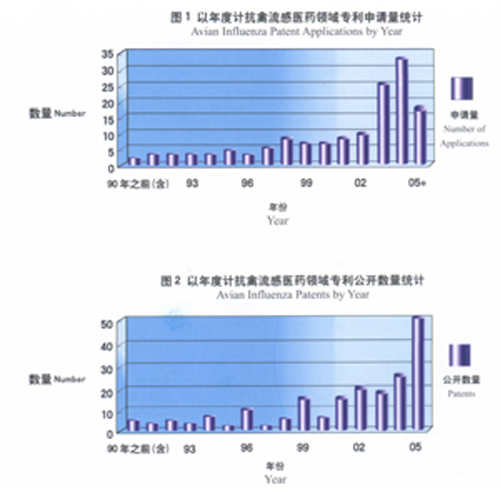
Note1:05*is the amount of published patents in 2005,of which cut-off date is June 6,2005.
The sources of patent applications are shown in figure 3. Although the proportion of domestic applications reaches as high as 73%, most of the original fundamental compound patent applications belong to oversea universities and scientific institutions and so on, including the pre-research companies. The international applications usually designate- or enter in China, which indicates their attention on Chinese medicine markets. The domestic applications are mostly filed by scientific institutions and medicine & pharmacy enterprises. Wherein the patent applications filed by scientific institutions involve many fields such as medical treatment, vaccine, detection, prevention and so on, and that the applications by pharmacy enterprise mainly involve the fields of medical treatment, vaccine etc. Moreover most of individual applications are relating to the Chinese traditional medicine applications in prevention area, and few of them possess mature technology and bright prospects for patent rights.
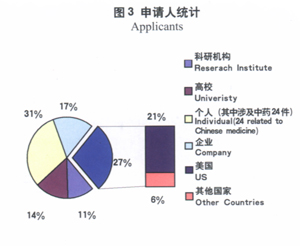
Chinese published patent applications relating to the following areas: medical treatment, vaccine, detection, prevention (see figure 4). These applications mainly cover the preparations for medical (A61K), microbiology & investigating (C12N, C12Q, G01N), compound & composition (C07D, C07H, C07K, C08B) and production & living (A01K, A01N, A23K, A23L, A36K, A47C, A61J, A61N) and others (see figure 5). More specifically, the domestic patent applications have few effective medical variety, unstable antivirus ability, limited productive capacity, weakness of investigation on human AI vaccine, un-maturity new style vaccine for the variations and antibiotic nature of AI virus.
Though vaccine inoculation is the best method to prevent and control AI ,pharmaceutical investigation receives much attention, for lacking reliable method to forecast effectively of AI occurrence and epidemic periodicity . Ministry of Public Health mention three medicines in AI drug reserve scheme:amantadine, rimantadine and oseltamivir.
As the traditional anti-viral drugs, amantadine, rimantadine and their salts have been used in clinic for at least 30 years, with large quantities of the relating patents involving in the improvement of preparing technology and new treatment usage and so on. Patent applications include domestic and oversea ones, and the domestic applications are mainly filed by medicine enterprises and research institutions and so on.

Oseltamivir, being recognized internationally to be one of AI specific medicine at present, has caught much attention because of its limited supply caused by patent monopoly. Eighteen patent applications involving oseltamivir and its derivatives such as phosphate, citrate and hydrochloride thereof etc, have been published in China and some of them have been granted patent rights.Most applicants concentrated in the original research institutions or assigned rights and interests companies, and the patent applications mainly involve the improvement of preparation technology and intermediate.
Therefore, when it comes to domestic research on anti-avian influenza medicine in the near future, we should strengthen the research of medicine and vaccine on high and low pathogenic avian influenza. It is important to enhance systemic study on Chinese Traditional Medicine against IA, and it is necessary to improve detection method and carry on the clinical study as soon as possible. Meanwhile it calls for joint efforts and close cooperation between scientific research institutions and enterprises, as well as international cooperation to bring AI under control. We should also pay attention to the protection of useful information and to cerate initiative intellectual property through cooperation and sharing the achievements in this field to face the risk of a possible pandemic or worldwide outbreak of AI together.
9. Analysis and Forecast on Patent Applications Relating to Protection of Audio and Video Works
As the technologies of science and network develop, copying, editing, recording, and broadcasting audio and video works and other operations on audio and video works become more and more convenient and fast. Accordingly, it is more and more difficult to protect the copyright of audio and video works, thereby the copyright owners would lose their impetuses to make and create audio and video works. Now, the copyright owners pay attention to protect their works by a technique way greatly because the works of the copyright owners are always recorded on a certain media and transferred by a certain way. The technique used to realize the protection on audio and video works varies and develops as the analog and digital transfer formats of the audio and video works vary, storage media vary and the network develops.
The forms of the technique primarily include the encryption technique, the digital watermark technique, the digital fingerprint technique and the DRM technique etc. Initially, the encryption technique adds a copy-against information into audio and video signals directly, while the disadvantage is that the quality of audio and video signals would be affected. Later, some copy-against information is added into some subsidiary signals, thereby the audible or visual effect of the audio and video works would not be affected. Due to the limitation of the encryption technique, if someone gets the password by use of a certain technique, the copyright owners' would have an economic loss. the digital watermark and digital fingerprint techniques could make up the disadvantage of the encryption technique. The cover-up, safety, robust of the techniques ensure that the copyright information of audio and video works would not disappear after multi-processing. Furthermore, they could be used to track the pirates, and could be the basis of checking whether the audio and video works being used is legal or not. The previous encryption technique is used in the later digital watermark technique. By use of the combination of the encryption technique and the digital watermark technique, we could better solve the protection problems of audio and video works.
According to an incomplete statistics, to the end of June, 2005, the patent applications on audio and video works increase year after year(please notice that the patent documents of 2004 have not been published completely until June, 2005, so that the amount of patent applications of 2004 decreases compared with previous year). From fig 1, it could be seen obviously that the techniques for protecting audio and video copyright appear in 1970s, and increase fast in the duration from the end of 1980s to the beginning of 1990s. In the 21 century, as the electronic technology and internet technique develop quickly, the needs to protect copyright increase fast, thus resulting in the amount of application sharply increased year by year.
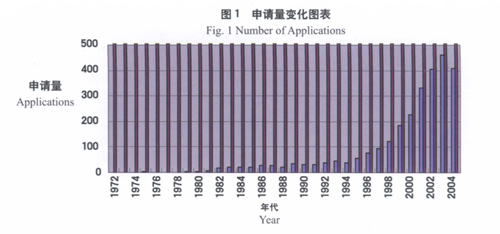
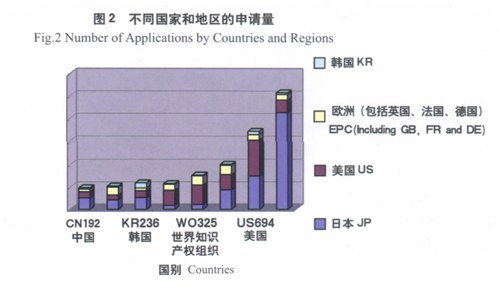
Further, it also could be seen obviously from fig 2 that, among the relating applicants of each countries, the techniques on audio and video works are mainly hold by the applicants of Japan, the United States, the members of EPC and Korea. The proportion of the Chinese applicants' copyright protection techniques is very small in this technical field.
Since the techniques on audio and video works are not originated from China, and the techniques were developed in China in recent years, the capability of China is weak in respect of mastering the techniques. As the techniques develop, many countries have determined various patent techniques to be industry standards.
10. Analysis and Forecast on Patent Applications Relating to Cement
As one of the top three basic materials in the construction industry, cement is widely used and enjoys a name of "food for construction industry". And, cement plays an important role in the national economy and people's livelihood relating to various fields such as civilian applications, military applications, water conservancy applications, and so on. However, the problem in cement industry is that cement is always consuming large amounts of energy resources and leading to heavy environment pollution. Therefore, at present, energy-saving in cement industry and use of industrial waste have become one of the most leading and important topics.
According to the undercount till November 30, 2005, the sum of patent applications under the International Patent Classification (IPC) codes C04B7 (hydraulic cements), C04B9 (magnesium cements or similar cements), C04B11 (calcium sulfate cements) and C04B12 (cements not provided for in groups C04B 7/00 - C04B 11/00) is 1099, wherein the annual amount of China's applications from 2000 to 2005 is 40, 22, 39, 56, 58 and 76, respectively. The output of cement in China has successively been in the first place for twenty years all over the world, and the yearly output has been already above 0.8 billion tons at present. The amount of applications relating to cement field has been increasing for several years, but from the fact that the amount of patent applications of the top five groups Conch Group, Huaxin Cement Co., Ltd, Sunnsy Group, Tangshan Jidong Cement Group Co., Ltd and Leomax Group is only 0, 14, 1, 4 and 0, respectively, it can be concluded that the technology innovation in the large-scale cement production enterprises has not yet come into being tendency.
It can be seen from the contents of the patent applications that the relatively active aspects in cement field still focus on raw materials and fuels. The patent applications on raw materials and fuels mainly concentrate on the following aspects: (1) looking for the substitutes for original raw materials of cement such as limestone, clay, iron ore and so on and hence decreasing the resources consumption, for example replacing high-grade limestone with low-grade limestone, replacing clay with sandshale, coal gangue and a variety of metallic ore tailings to protect farmland, utilizing industrial spent residue (such as slag, fly ash, red mud from aluminum production, carbide slag, phosphogypsum, calcic sludge containing oil), municipal wastes or building rubbish (such as rejected brick, waste ceramics, waste concrete, etc.) as raw materials of cement and composite material, utilizing industrial combustible waste materials as secondary fuel for cement production, etc.; (2) further improving or modifying the activity of the above substitutes, for example treating the fly ash with soluble carbonates, sulfates or phosphates to promote the cracking of the silicon-oxygen bond and aluminum-oxygen bond and thus destroy the hard surface structure of fly ash particles; decreasing the storage temperature of deeply-dealkalized red mud to a temperature of 5 to 55 degree centigrade by adding water, and adding sulfonated sodium humate or condensation polymer of methylol naphthalene sulphonic acid-formaldehyde, so as to solving the harden problem of red mud and increasing its consumption from 15% to over 50%; (3) adjusting the mineralogical composition in the clinker through adjusting feeds proportion to satisfy the demands for engineering, for example adding phosphoric compounds or phosphoric compounds and fluorine compounds to the crude materials to increase the content of tricalcium silicate (C3S) phase up to 66 ~ 76%, and C3S phase being the mixture of trigyric crystal lattice or trigyric crystal lattice and monoclinic lattice; (4) co-producing inorganic salts and cement, utilizing slags discharged from production processes of inorganic salts to produce the clinker, for example co-producing yellow phosphorus, alumina or phosphoric acid, etc. with cement; (5) new-type cement, for example silica-alumina system cement which is only grinded once and different from silica-calcium system cement based on the fundamental principle of "twain whet and single firing".
At present, there are several-billion tons of solid wastes in China, wherein the amount of coal gangue is as high as 3.4 billions tons. The amount of these solid wastes increases at the rate of 1 billion tons per year, which has become a heavy burden on the environment. In China, the cost of fly ash disposal amounts to 6.0 billions Yuan annually, therefore, in the case of raw materials and fuels of cement, the directions of research and development remain how the potential reactivity of a variety of wastes can be excited, thereby developing the composite cement incorporating a large amount of wastes.
2013-07-17
 Print
Print